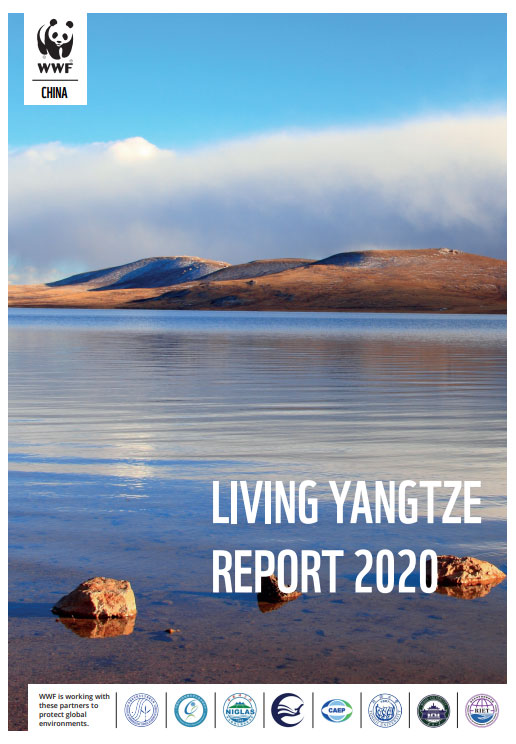Restoring the Health of Yangtze River is Critical for People and Nature
The first Living Yangtze Report describes health of the river and recommends how to improve it.
 |
|
Living Yangtze Report 2020
? WWF-China |
WWF - The world’s freshwater ecosystems are in crisis. WWF’s Living Planet Report 2020 found that freshwater species populations have collapsed by 84 per cent on average since 1970, highlighting the damage we have done to our rivers, lakes and wetlands – ecosystems that are crucial to the ecological balance of the planet, and provide vital services to our society and economy.
A healthy Yangtze river basin is central to China’s future. It provides water, food and livelihoods for hundreds of millions of people and sustains much of the Chinese economy. It is also home to incredible biodiversity from giant pandas and snow leopards to over 400 species of fish and the world’s only freshwater porpoise. But today, the Yangtze is under immense pressure and it’s health is failing fast.Preserving biodiversity in the Yangtze, restoring ecosystems to a healthy state, and achieving proper management and sustainable use of resources will be vital to the economic and social development of China.This new Living Yangtze Report – the world’s first Living River report – provides an authoritative analysis of the current challenges in the basin, including climate change, alterations to its flow, land-use change and river-bank development, pollution, overfishing and invasive species. These pressures threaten the river’s wealth of ecosystem services from water supplies to freshwater fisheries that feed millions, and mitigation of extreme floods and droughts.At the heart of the report is the Yangtze Living Index (LYI), which looks at the hydrology, water quality and aquatic biodiversity along the river. The LYI concludes that the overall health of the Yangtze river basin is declining with its status deteriorating as the river flows from source to sea. The condition of the Yangtze’s four largest freshwater lakes is even more concerning.Specifically, the LYI grade the mainstem of the river as B-. The source region is the healthiest (Grade A), while the middle of the Yangtze is under serious stress (C). Meanwhile, one of the river’s four large freshwater lakes, Chaohu Lake, received the lowest grade of all – a D-.The index is a cutting-edge scientific tool that supports effective management of the river basin by providing a comprehensive set of data to track progress in biodiversity conservation, ecosystem restoration and the sustainability of the river’s priceless natural resources.Along with describing the current health of the river, the report also provides detailed suggestions to improve it. For the source region, for example, it is crucial to tackle climate change and enhance the protection of natural reserves among other measures, while water flows and development of hydropower need to be strictly regulated to enhance the status of the Upper Yangtze. Downstream, some of the key measures in the Middle Yangtze include improving management of livestock, promoting sustainable fisheries, and restoring and protecting natural river banks and riparian wetlands.There should be more focus on species diversity conservation, habitat preservation, and management of the nature reserves in Poyang Lake and Dongting Lake. For the Lower Yangtze, there is an urgent need to improve sewage management, and protect and restore the wetland ecosystems along the rivers and the lakes. Endemic species, such as the iconic Yangtze finless porpoise and rare fishes, should be protected. Meanwhile, the discharge of pollutants into Taihu Lake and Chaohu Lake should be tightened.As the first complete basin-level index in the world, the Living Yangtze Index is also an innovation that will hopefully be replicated across the world. We will not be able to reverse the loss of freshwater ecosystems and the decline in freshwater biodiversity until we better understand the status of the world’s major river basins.Thanks to the Living Yangtze Report, which was developed by WWF in partnership with eight research institutes in China, we now have a much more accurate picture of the health of Asia’s longest river and how best to improve it for the benefit of the millions of people and the rich biodiversity it supports."I am confident that this report will contribute significantly to the effectiveness of efforts by the government, communities, companies and conservationists like WWF to restore the Yangtze to health – and help drive sustainable development in China," said Marco Lambertini, Director General, WWF International.------The Living Yangtze Report was co-produced by WWF and the Institute of Hydrobiology of the Chinese Academy of Sciences (CAS), Institute of Geographic Sciences and Natural Resources Research of CAS, Nanjing Institute of Geography & Limnology of CAS, Changjiang River Scientific Research Institute of the Changjiang Water Resources Commission, Chinese Academy of Environmental Planning of the Ministry of Ecology and Environment, P.R.C, Key Laboratory of Yangtze River Water Environment, Ministry of Education (Tongji University), School of Water Resources and Hydropower Engineering of Wuhan University, and Research Institute for Environmental Innovation (Suzhou) Tsinghua.

